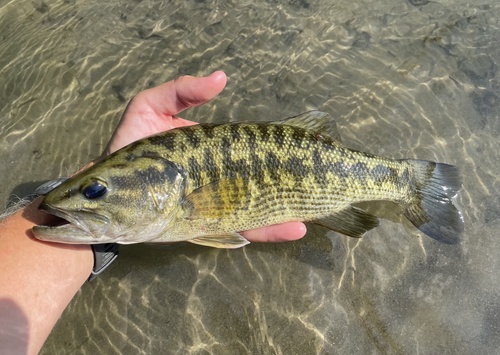
Guadalupe Bass
The Atlantic bluefin tuna (Thunnus thynnus) is a majestic and powerful fish renowned for its size, speed, and commercial value. This highly migratory species plays a critical role in the marine ecosystem and has been a prized catch for centuries.
0 7 years
Lifespan
43 cm
Length
Near Threatened
Conservation Status
19 km/h
Swimming speed
Carnivorous, Insectivorous
Diet
Local Migration
Migration
Appearance Overview
The Atlantic bluefin tuna is a large, streamlined fish with a metallic blue body and a silvery underside.
Color
Dark metallic blue on top, silvery underside
Body Shape
Torpedo-shaped, built for speed and endurance
Fins
Two dorsal fins, the first depressible; small finlets run from dorsal and anal fins to the tail
Keel
Strong lateral keel on the caudal peduncle
Length
Up to 13 feet (4 meters), commonly around 6.5 feet (2 meters)
Weight
Up to 2,000 lbs (907 kg), commonly around 550 lbs (250 kg)
Diet
Carnivorous, feeding on a variety of fish (such as herring, mackerel, and hake), squid, and crustaceans.
Feeding Behavior
Highly active predator, using speed and agility to hunt. They can dive to significant depths and often hunt cooperatively, herding prey.
Social Behavior
Forms large schools, especially when young. Larger individuals may be more solitary or form smaller groups. Highly migratory, traveling vast distances.
Commercial Relevance
Extremely high value, particularly in the sushi and sashimi markets, where a single fish can sell for tens or even hundreds of thousands of dollars.
Conservation measures
Subject to international fishing quotas and management plans (e.g., ICCAT). Some regions have implemented stricter regulations, including seasonal closures and gear restrictions. Marine Protected Areas also play a role.
Status
Varies by population; some are considered Endangered (e.g., Southern bluefin tuna) or Vulnerable, while others are Near Threatened. The IUCN lists the Atlantic bluefin tuna as Endangered.
Threats
Overfishing (historically and ongoing in some areas), bycatch in fisheries targeting other species, climate change (affecting prey distribution and spawning grounds), and habitat degradation.
Habitat Distribution
Depth Range
Surface waters to depths of over 3,000 feet (1,000 meters), although they typically spend time in the upper part of the water column.
Geographic Range
Widely distributed in the North Atlantic Ocean, from the Gulf of Mexico and the Mediterranean Sea to Norway and Newfoundland.
Preferred Environment
Primarily pelagic (open ocean), but they also frequent coastal waters, especially during spawning season. They prefer temperate and subtropical waters.
Reproduction and Life Cycle
Breeding Habits
Spawns in warm waters, with major spawning grounds in the Gulf of Mexico and the Mediterranean Sea. Spawning typically occurs from April to June in the Gulf of Mexico and from May to July in the Mediterranean.
Development Stages
Eggs are pelagic (floating in the open water). Larvae are planktonic and grow rapidly. Juveniles form schools and gradually mature into adults.
Fecundity
Highly fecund; a single female can produce up to 30 million eggs per spawning season, depending on her size and condition.
Maturity Age
Reaches sexual maturity at around 4-8 years of age, although this can vary depending on location and environmental conditions.
Faqs about Guadalupe Bass
Where are Atlantic bluefin tuna found?
Atlantic bluefin tuna are found throughout the Atlantic Ocean, including the Mediterranean Sea.
What do Atlantic bluefin tuna eat?
They are carnivores, feeding on fish, squid, and crustaceans.
How long do Atlantic bluefin tuna live?
They can live up to 40 years, although this is rare due to fishing pressure.
Can you eat Atlantic Bluefin Tuna?
Yes, but many populations are overfished, and strict regulations are in place in many areas.
How many eggs do bluefin tuna lay?
Females can release millions of eggs during spawning season.
How fast can Atlantic bluefin tuna swim?
They are among the fastest fish in the ocean, capable of bursts of speed up to 40-60 mph.
Are Atlantic bluefin tuna warm-blooded?
Atlantic bluefin tuna are warm-blooded, which is unusual for fish, allowing them to maintain a higher body temperature than the surrounding water.
Copyright @ Nature Style Limited. All Rights Reserved.
 English
English